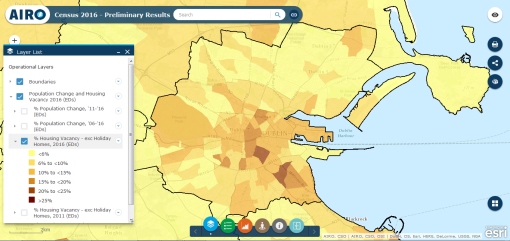For the past couple of years the housing discourse for Dublin city has been one of housing shortages and a homeless crisis. The preliminary census figures published yesterday reveal that while the vacancy rates (exc holiday homes) for South Dublin (4%), Dún Laoghaire-Rathdown (5.7%) and Fingal (5.3%) are below a base vacancy level of 6% (in a ‘normal’ market we would expect c.6% of stock to be vacant due to selling/rental gaps, deaths, etc), suggesting that they have housing undersupply, Dublin City Council has a vacancy rate of 8.6% (exc. holiday homes).
In total DCC has 21,781 vacant units (20,844 exc holiday homes). On a base vacancy of 6% (14,544 units) that suggests an oversupply of 6,300.
In other words, there is something pretty odd going on given the homeless rate has been increasing, large numbers are on the housing waiting list, and there’s a widespread belief that the city desperately needs to build housing.
So, what constitutes these 6,300 excess vacant units?
It’s somewhat difficult to know without visiting them and doing an on-the-ground survey, but let’s start with looking at the geography of vacancy in DCC. Map 1 shows the % vacancy in the city minus holiday homes, and Map 2 shows change in the number of vacant units since 2011.
In Map 1, all the areas not shaded pale yellow has a vacancy rate (exc. holiday homes) above 6% base vacancy. Much of the city centre and to the south have rates above 10%, and two EDs have rates above 20% (Mansion House B, Pembroke West B). In Map 2, the blue areas have seen vacancy rates decline between 2011 and 2016, whereas red areas have seen an increase. Interestingly, a number of areas have seen quite large increases in vacancy, especially within the canals near to the city centre, Ballsbridge and Rathmines.
Here’s some speculation as to what constitutes the excess vacancy:
- some unreported airbnb/similar stock;
- some second homes (used during week, but primary residence recorded as somewhere else);
- some investment stock left empty;
- some bedsits not yet converted after change in regulations that made them illegal;
- some inner city obsolescence.
I’d be interested to hear about other possibilities.
Whatever the reason for the vacancy, it appears that this stock is not presently available to the market and therefore there continues to be a shortage of housing in the capital.
Rob Kitchin


July 15, 2016 at 9:20 am
There are many factors which distort the figures of this survey. One in particular, which is relevant to holiday and second homes is that quite often holiday homes were registered in wife/husband/offspring’s name or whatever was different to the named owner of the primary residence, in order to avoid various taxes, duties and obligations. We used to see it down in Wexford, I don’t know how prevalent it is now. In many coastal areas more than half the local housing stock is a second (or sometimes even third or fourth) home.
This meant that a family could have a couple of properties that they use for holiday premises all with different owners. However only one would actually be occupied at any one time.
This distorts the figures above even further as the houses, while largely unoccupied, are not counted in statistics as such. I would suspect that the figures above are a conservative estimate and could easily be revised upwards.
July 15, 2016 at 9:34 am
I’d suggest property in transfer from one owner to another, or property owned by elderly people now in homes, or properties caught up in the legal system due to lack of wills etc is the main reason. As well as the persistent and unchallenged under-use of buildings in the city centre.
July 15, 2016 at 10:18 am
David, I would suspect there is an unreporting of second homes and holiday rental property as part of overall vacancy level and agree that that form of vacancy could be revised upward. I’m not sure it would account for 6300 properties above base vacancy, however.
Stephenc, what you describe is a usual part of base vacancy. If it was a significant issue beyond that we would expect it to be an issue everywhere – including the other 3 Dublin authorities.
July 15, 2016 at 11:47 am
two types of vacancy in my part of D5 are ; pyrite affected new builds and empties attributed to jingle mail by immigrants leaving the state to escape unsustainable mortgages – both would amount to less than 10 units in the ED. Overall I imagine there is a very diverse range of reasons for property vacancy post-downturn.
July 18, 2016 at 8:27 pm
Empty due to mortgage arrears perhaps?
July 19, 2016 at 8:07 pm
[…] biggie is why, at a time of housing shortage and homelessness, there are apparently 6,300 more vacant residential units in the city than you would expect, as Rob Kitchin of […]
July 20, 2016 at 2:54 pm
One part is probably empty DCC stock that has scheduled for refurbishment. For example St Teresa’s Gardens in D8. There are a few of these in the north inner city too.
The peculiar increase around Donnybrook is likely private investment ready for demolition. AFAIK the former Burlington was apartments in 2011 and a lot of the triangle between Shelbourne, Lansdowne and Pembroke roads was awaiting redevelopment the last time I passed.
I am very puzzled by Sandymount and Terenure/Rathgar though.
July 25, 2016 at 11:14 am
One possible, perhaps small, contributor to vacancies being higher in 2016 than in 2011 in a given area is the scale of recent completions just prior to the Census — as these inevitably don’t sell and become occupied immediately. The housing stats suggest about 680 completions in Dublin city/county in Jan-April 2011 and 1,300 such completions in Jan-April 2016.